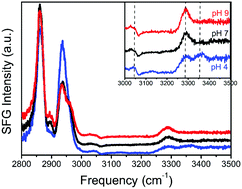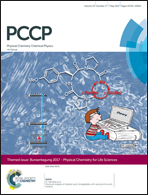Identification of the response of protein N–H vibrations in vibrational sum-frequency generation spectroscopy of aqueous protein films†
Abstract
The N–H stretching vibration is an important probe for investigating structural and functional properties of proteins but is often difficult to analyze as it overlaps with the O–H stretching vibration of water molecules. In this work we investigate the N–H signals of hydrophobins using conventional (VSFG) and heterodyne-detected vibrational sum-frequency generation spectroscopy (HD-VSDG). Hydrophobins represent a group of surface active proteins that form highly-ordered protein films at the water–air interface and that give rise to prominent vibrational modes. We find that in conventional VSFG spectra N–H specific signals show significant changes in shape and intensity upon altering the pH values. These changes can easily be misinterpreted for conformational changes of the protein. Using HD-VSFG experiments, we demonstrate, that for hydrophobin films the change of the N–H response with pH can be well explained from the interference of the N–H response with the broad interfacial water O–H stretch band.

- This article is part of the themed collection: Bunsentagung 2017: Physical Chemistry for Life Sciences


 Please wait while we load your content...
Please wait while we load your content...